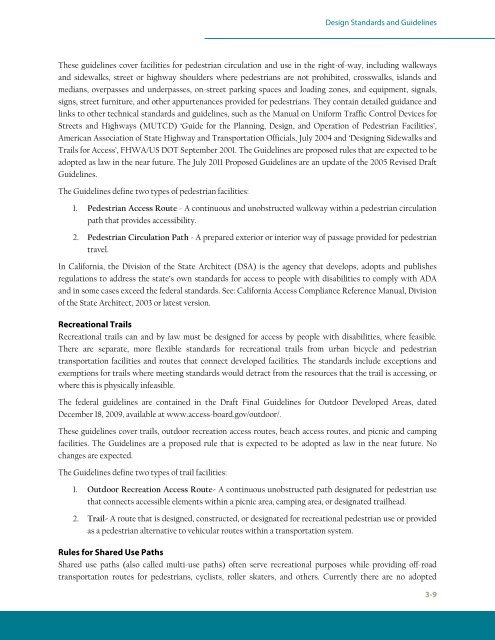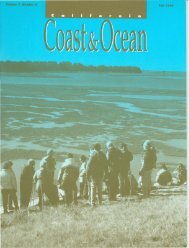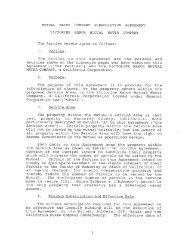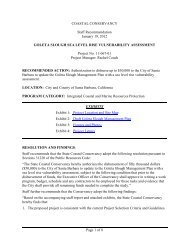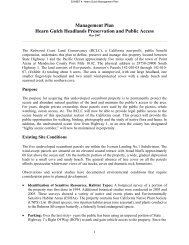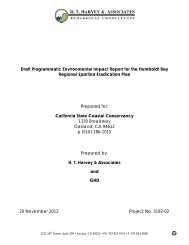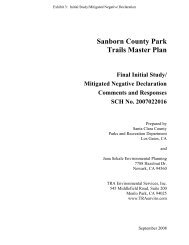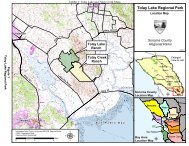Northern San Luis Obispo County Coastal Trail Master Plan
Northern San Luis Obispo County Coastal Trail Master Plan
Northern San Luis Obispo County Coastal Trail Master Plan
Create successful ePaper yourself
Turn your PDF publications into a flip-book with our unique Google optimized e-Paper software.
Design Standards and Guidelines<br />
These guidelines cover facilities for pedestrian circulation and use in the right-of-way, including walkways<br />
and sidewalks, street or highway shoulders where pedestrians are not prohibited, crosswalks, islands and<br />
medians, overpasses and underpasses, on-street parking spaces and loading zones, and equipment, signals,<br />
signs, street furniture, and other appurtenances provided for pedestrians. They contain detailed guidance and<br />
links to other technical standards and guidelines, such as the Manual on Uniform Traffic Control Devices for<br />
Streets and Highways (MUTCD) ‘Guide for the <strong>Plan</strong>ning, Design, and Operation of Pedestrian Facilities’,<br />
American Association of State Highway and Transportation Officials, July 2004 and ‘Designing Sidewalks and<br />
<strong>Trail</strong>s for Access’, FHWA/US DOT September 2001. The Guidelines are proposed rules that are expected to be<br />
adopted as law in the near future. The July 2011 Proposed Guidelines are an update of the 2005 Revised Draft<br />
Guidelines.<br />
The Guidelines define two types of pedestrian facilities:<br />
1. Pedestrian Access Route - A continuous and unobstructed walkway within a pedestrian circulation<br />
path that provides accessibility.<br />
2. Pedestrian Circulation Path - A prepared exterior or interior way of passage provided for pedestrian<br />
travel.<br />
In California, the Division of the State Architect (DSA) is the agency that develops, adopts and publishes<br />
regulations to address the state’s own standards for access to people with disabilities to comply with ADA<br />
and in some cases exceed the federal standards. See: California Access Compliance Reference Manual, Division<br />
of the State Architect, 2003 or latest version.<br />
Recreational <strong>Trail</strong>s<br />
Recreational trails can and by law must be designed for access by people with disabilities, where feasible.<br />
There are separate, more flexible standards for recreational trails from urban bicycle and pedestrian<br />
transportation facilities and routes that connect developed facilities. The standards include exceptions and<br />
exemptions for trails where meeting standards would detract from the resources that the trail is accessing, or<br />
where this is physically infeasible.<br />
The federal guidelines are contained in the Draft Final Guidelines for Outdoor Developed Areas, dated<br />
December 18, 2009, available at www.access-board.gov/outdoor/.<br />
These guidelines cover trails, outdoor recreation access routes, beach access routes, and picnic and camping<br />
facilities. The Guidelines are a proposed rule that is expected to be adopted as law in the near future. No<br />
changes are expected.<br />
The Guidelines define two types of trail facilities:<br />
1. Outdoor Recreation Access Route- A continuous unobstructed path designated for pedestrian use<br />
that connects accessible elements within a picnic area, camping area, or designated trailhead.<br />
2. <strong>Trail</strong>- A route that is designed, constructed, or designated for recreational pedestrian use or provided<br />
as a pedestrian alternative to vehicular routes within a transportation system.<br />
Rules for Shared Use Paths<br />
Shared use paths (also called multi-use paths) often serve recreational purposes while providing off-road<br />
transportation routes for pedestrians, cyclists, roller skaters, and others. Currently there are no adopted<br />
3-9


